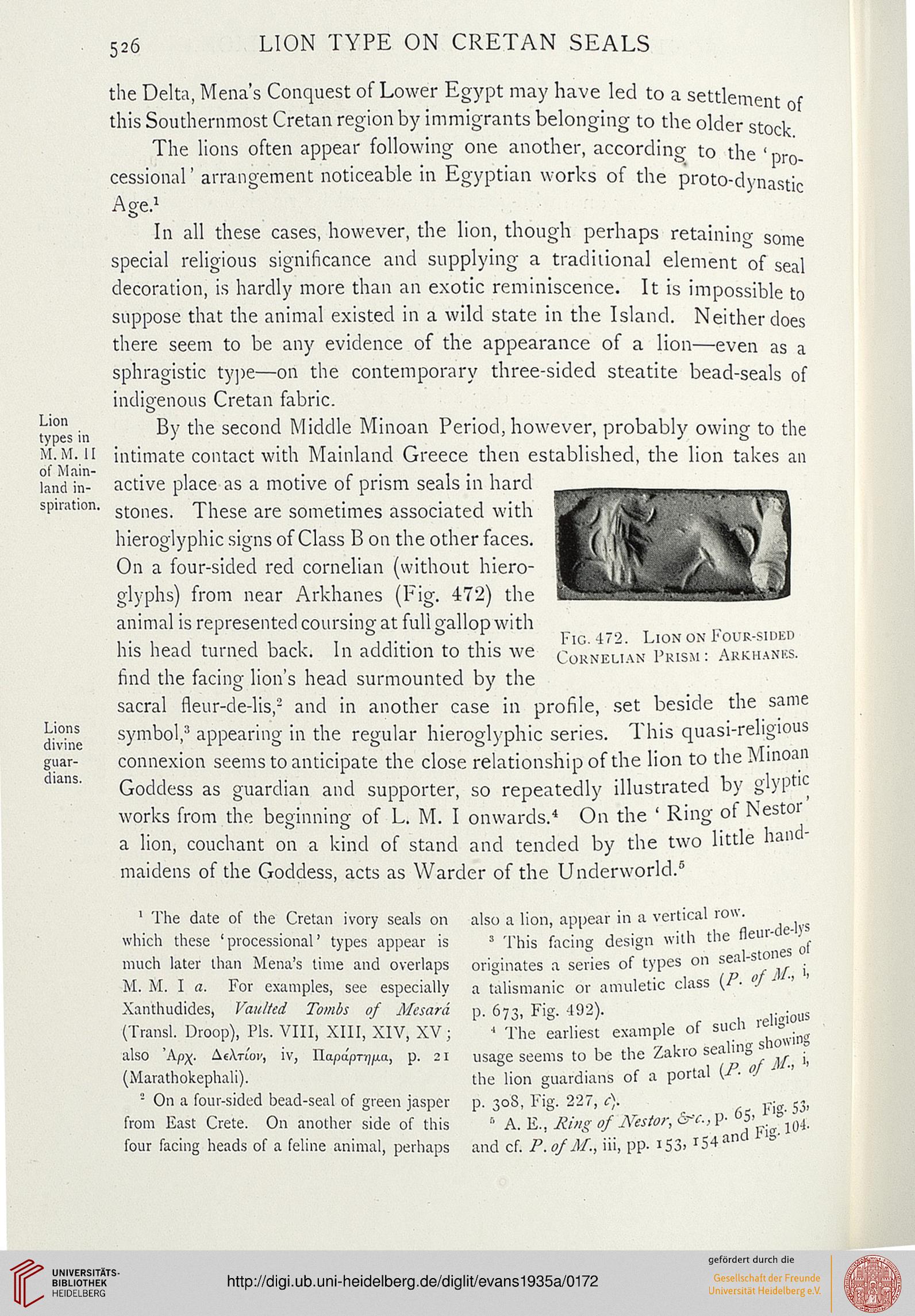526
LION TYPE ON CRETAN SEALS
Lion
types in
M.M. II
of Main-
land in-
spiration.
guar-
dians.
the Delta, Mena's Conquest of Lower Egypt may have led to a settlement f
this Southernmost Cretan region by immigrants belonging to the older stock
The lions often appear following one another, according to the ' pro
cessional' arrangement noticeable in Egyptian works of the proto-dynastic
Age.1
In all these cases, however, the lion, though perhaps retainino- sonle
special religious significance and supplying- a traditional element of seal
decoration, is hardly more than an exotic reminiscence. It is impossible to
suppose that the animal existed in a wild state in the Island. Neither does
there seem to be any evidence of the appearance of a lion—even as a
sphragistic type—on the contemporary three-sided steatite bead-seals of
indigenous Cretan fabric.
By the second Middle Minoan Period, however, probably owing to the
intimate contact with Mainland Greece then established, the lion takes an
active place as a motive of prism seals in hard
stones. These are sometimes associated with
hieroglyphic signs of Class B on the other faces.
On a four-sided red cornelian (without hiero-
glyphs) from near Arkhanes (Fig. 472) the
animal is represented coursing at full gallop with
his head turned back. In addition to this we
find the facing lion's head surmounted by the
sacral fleur-de-lis,2 and in another case in profile, set beside the same
symbol,3 appearing in the regular hieroglyphic series. This quasi-religious
connexion seems to anticipate the close relationship of the lion to the Minoan
Goddess as guardian and supporter, so repeatedly illustrated by glyptic
works from the beginning of L. M. I onwards.4 On the ' Ring of Nestor
a lion, couchant on a kind of stand and tended by the two little ha«d"
maidens of the Goddess, acts as Warder of the Underworld.6
Fig. 472. Lion on Four-sided
Cornelian Prism : Arkhanes.
1 The date of the Cretan ivory seals on
which these 'processional' types appear is
much later than Mena's time and overlaps
M. M. I a. For examples, see especially
Xanthudides, Vaulted Tombs of Mesard
(Transl. Droop), Pis. VIII, XIII, XIV, XV;
also 'Apx- AeXlw, iv, Hapdprrjfj.a, p. 21
(Marathokephali).
- On a four-sided bead-seal of green jasper
from East Crete. On another side of this
four facing heads of a feline animal, perhaps
also a lion, appear in a vertical row.
s This facing design with the ^u''d^
originates a series of types on se*ston^ ■
a talismanic or amuletic class (/• "f
p. 673, Fig.-192).
< The earliest example of such reiw
usage seems to be the Zakro sealing sho^ j>
the lion guardians of a portal {!>■ °J
p. 308, Fig. 227, 4 - s3,
■ A. E., Ring of Nestor, &■(., P- »S> * t
and cf. P. ofM., iii, pp. ■ 53. '54 and s"
LION TYPE ON CRETAN SEALS
Lion
types in
M.M. II
of Main-
land in-
spiration.
guar-
dians.
the Delta, Mena's Conquest of Lower Egypt may have led to a settlement f
this Southernmost Cretan region by immigrants belonging to the older stock
The lions often appear following one another, according to the ' pro
cessional' arrangement noticeable in Egyptian works of the proto-dynastic
Age.1
In all these cases, however, the lion, though perhaps retainino- sonle
special religious significance and supplying- a traditional element of seal
decoration, is hardly more than an exotic reminiscence. It is impossible to
suppose that the animal existed in a wild state in the Island. Neither does
there seem to be any evidence of the appearance of a lion—even as a
sphragistic type—on the contemporary three-sided steatite bead-seals of
indigenous Cretan fabric.
By the second Middle Minoan Period, however, probably owing to the
intimate contact with Mainland Greece then established, the lion takes an
active place as a motive of prism seals in hard
stones. These are sometimes associated with
hieroglyphic signs of Class B on the other faces.
On a four-sided red cornelian (without hiero-
glyphs) from near Arkhanes (Fig. 472) the
animal is represented coursing at full gallop with
his head turned back. In addition to this we
find the facing lion's head surmounted by the
sacral fleur-de-lis,2 and in another case in profile, set beside the same
symbol,3 appearing in the regular hieroglyphic series. This quasi-religious
connexion seems to anticipate the close relationship of the lion to the Minoan
Goddess as guardian and supporter, so repeatedly illustrated by glyptic
works from the beginning of L. M. I onwards.4 On the ' Ring of Nestor
a lion, couchant on a kind of stand and tended by the two little ha«d"
maidens of the Goddess, acts as Warder of the Underworld.6
Fig. 472. Lion on Four-sided
Cornelian Prism : Arkhanes.
1 The date of the Cretan ivory seals on
which these 'processional' types appear is
much later than Mena's time and overlaps
M. M. I a. For examples, see especially
Xanthudides, Vaulted Tombs of Mesard
(Transl. Droop), Pis. VIII, XIII, XIV, XV;
also 'Apx- AeXlw, iv, Hapdprrjfj.a, p. 21
(Marathokephali).
- On a four-sided bead-seal of green jasper
from East Crete. On another side of this
four facing heads of a feline animal, perhaps
also a lion, appear in a vertical row.
s This facing design with the ^u''d^
originates a series of types on se*ston^ ■
a talismanic or amuletic class (/• "f
p. 673, Fig.-192).
< The earliest example of such reiw
usage seems to be the Zakro sealing sho^ j>
the lion guardians of a portal {!>■ °J
p. 308, Fig. 227, 4 - s3,
■ A. E., Ring of Nestor, &■(., P- »S> * t
and cf. P. ofM., iii, pp. ■ 53. '54 and s"





